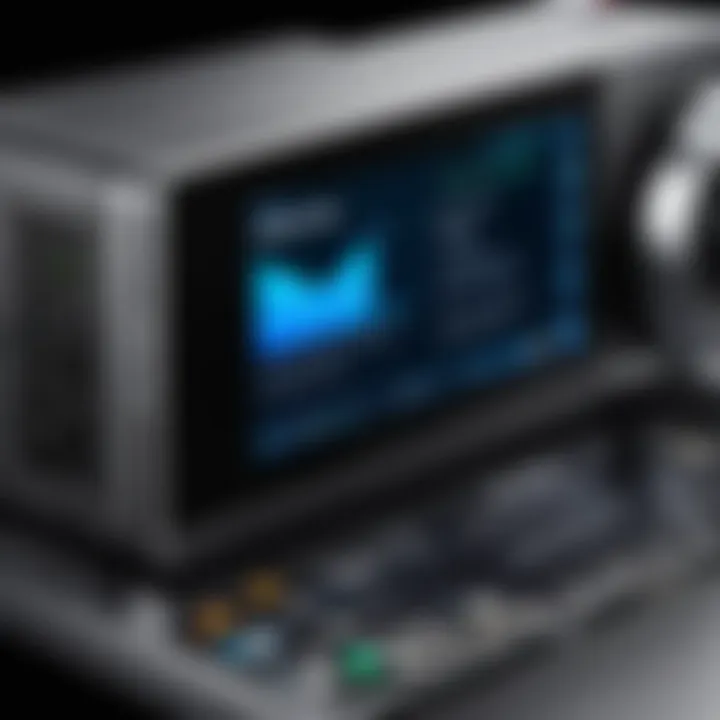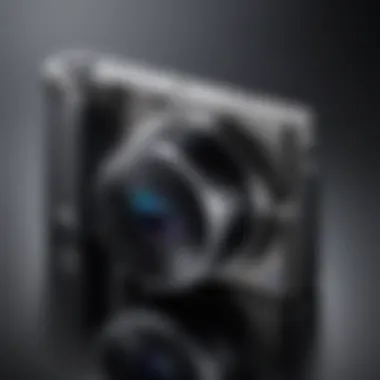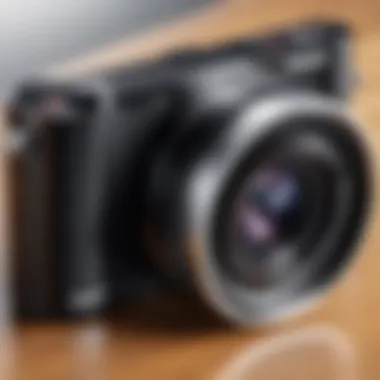Setup Guide for Samsung Smart Cameras: Step-by-Step


Intro
In an era where security and smart technology blend seamlessly, the Samsung Smart Camera emerges as a front-line defender against potential threats while also amplifying your home automation experience. Setting up these devices, however, can feel akin to trying to decipher a foreign language for the uninitiated. This article aims to guide IT professionals and tech aficionados through the entire setup process, ensuring both the tech savviness and the cautious layman find their footing with confidence.
The narrative begins with the essentials: unboxing your new gadget, understanding the key specifications, and setting the stage for integration into your existing system. Each section is crafted to walk you through the practical aspects, from installation to advanced configurations. By the end, readers can expect to wield their Samsung Smart Camera not just as a device but as an integral part of their security strategy, capable of providing peace of mind and seamless performance.
Features Overview
Samsung Smart Cameras come loaded with features that make them a worthy addition to any tech-savvy household. They are not merely about recording; they are designed for convenience and effectiveness, ensuring you reap the benefits without the headaches.
Key Specifications
- Resolution: Ranging up to 4MP, delivering crisp images day or night.
- Field of View: Wide-angle options allow you to cover more area, reducing blind spots.
- Connectivity: Wi-Fi enabled for easy integration with smart home networks.
- Night Vision: Equipped with infrared capabilities, ensuring visibility in low-light conditions.
Unique Selling Points
- Smart Features: Integrates well with voice assistants like Google Assistant or Amazon Alexa, allowing hands-free control.
- Cloud Storage Options: Provides flexibility in storing footage securely, accessible anytime and anywhere.
- Motion Detection Alerts: Notifies you in real-time through mobile apps, so you can always stay aware of your surroundings.
"Understanding the capabilities of your Samsung Smart Camera can make all the difference in maximizing its functionality."
Performance Analysis
When diving into performance, it's essential to consider both benchmark results and real-world scenarios to get a holistic view of what the Samsung Smart Camera can do.
Benchmarking Results
In lab tests, Samsung Smart Cameras have consistently performed well against competitors in terms of clarity, range, and responsiveness. For instance, images taken during peak performance hours showed a significant advantage in color accuracy and detail retention. Moreover, the latency encountered in alerts was often less than a second, proving it to be reliable.
Real-world Scenarios
Consider a practical setup in a suburban home where there's a need to monitor the front lawn and back garden:
- The front lawn sees daily traffic—neighbors walking by, delivery personnel, etc. Here, the wide-angle lens captures everything without any glitch.
- The back garden, often shrouded in shadows during evenings, showcases the effectiveness of night vision as it clearly records movements without creeping shadows causing distortion.
In essence, every feature contributes to both the simplicity of setup and ongoing performance, offering a robust solution for those keen to bolster their home security.
As we proceed, we will dive deeper into the nuances of network setup, smart functionality integrations, and troubleshooting common snafus that may arise during your journey with Samsung Smart Cameras.
Preface to Samsung Smart Cameras
In today's tech-driven world, security and monitoring systems have come a long way, and Samsung Smart Cameras are a prime example of this evolution. These cameras offer a robust solution that goes beyond traditional surveillance methods. For IT professionals and tech enthusiasts, understanding the role of Samsung Smart Cameras is crucial, as they provide not only security but also comfort and convenience.
The beginning of the user journey starts with recognizing the countless benefits these devices bring to the table. For instance, Samsung Smart Cameras excel in offering high-definition video quality that guarantees clear visuals, even in low-light settings. This feature is a game changer for anyone aiming to keep a close watch on their surroundings.
Moreover, these cameras come equipped with advanced motion detection technologies and alert systems. Users can receive real-time notifications on their mobile devices, making it possible to monitor situations as they unfold. In this age of rapid information flow, being informed promptly can make a world of difference in personal safety and proactive security measures.
Key Considerations
While the benefits are numerous, it is vital to keep certain considerations in mind before diving into the setup process. Understanding the compatibility of these cameras with your existing technology is fundamental. Samsung Smart Cameras typically require specific operating systems on smartphones and tablets—failing to ensure compatibility can lead to a frustrating experience. Therefore, familiarity with your system requirements ahead of time can save you valuable hours in the long run.
Additionally, the performance of these devices heavily relies on a stable and high-speed internet connection. A sluggish or interrupted network can affect the camera's function, making it imperative to assess your Wi-Fi network specs before setting up. Proper planning can aid in a more seamless installation process, ultimately saving time and confusion.
To sum it up, the introduction of Samsung Smart Cameras into your life can bring peace of mind, knowing you have the tools to monitor your home or business effectively. As we delve deeper into this guide, each section will unveil the technical steps needed to harness these advanced features fully. By understanding these essentials, you'll be better prepared to tackle the setup and enjoy the myriad advantages that Samsung Smart Cameras have to offer.
Unboxing the Samsung Smart Camera
Unboxing the Samsung Smart Camera is often the first tangible step into a world of enhanced security and connectivity. This part of the setup process lays the groundwork for the experience that is to follow. Often overlooked, unboxing can provide key insights into what to expect and how to best interact with the device. Ensuring you fully grasp the components and their purposes can save time and frustration down the line. Plus, you never get a second chance at a first impression. Opening the box and examining what's inside not only builds anticipation but also ensures you are well-informed about the setup process.
Contents of the Box
Inside the package, you will find a neat arrangement of essential components designed to get you started right away. Here’s a breakdown of what you should typically expect:
- Samsung Smart Camera: The centerpiece of the whole operation. It's likely to be wrapped carefully to prevent damage.
- Power Adapter: A necessary component for keeping your camera powered.
- Mounting Kit: If you plan to install your camera on a wall or ceiling, this can be quite handy.
- User Manual: Though it may feel redundant for the tech-savvy, it contains valuable information that can assist you.
- Warranty Registration Card: Keeping your warranty handy is important for any unexpected hiccups.
Taking a moment to familiarize yourself with these components can make a significant difference in your installation experience. You don't want to be scrambling to find parts while in the middle of setup.
Initial Impressions
Once the device is out of its packaging, the initial impressions matter. Grab the camera and feel its weight in your hand. A well-designed product should feel solid but not cumbersome. The camera's body may have a sleek finish, a subtle nod to Samsung's commitment to aesthetics paired with functionality. Pay attention to the buttons and ports. Are they intuitive? You should be able to gauge how easy it will be to set up the device based on your first encounter.
Additionally, consider the design elements. Some cameras come with functionalities like night vision or two-way audio, and these features should be apparent within the camera's structure.
"The first impressions and contents of the box play a critical role in setting the stage for a smooth experience with your Samsung Smart Camera."
An enlightening thought might be to think about how this unboxing experience frames your expectations for performance and usability. All in all, these initial steps are crucial in establishing a seamless path towards integrating the Samsung Smart Camera into your daily life.
System Requirements for Samsung Smart Cameras
Understanding the system requirements for your Samsung Smart Camera isn’t just a formality; it’s a critical first step to ensuring optimal functionality. System requirements lay the groundwork for everything else in your setup process. When you have a clear grasp of what’s needed, you’ll save yourself all sorts of headaches down the line. After all, nothing’s worse than getting halfway through installation only to discover your operating system or network isn’t up to speed. Let’s dive into the nitty-gritty.
Operating Systems Compatibility
In today’s tech landscape, various operating systems possess their unique quirks. Samsung Smart Cameras play nice with certain versions, and it’s crucial to get this right from the get-go. Here’s what you need to know:
- Windows Operating Systems: Generally, the latest versions of Windows should be compatible. Windows 10 and later versions are usually the safest bet. Older systems, like Windows 8 or 7, may not receive updates or support, which can limit functionality.
- Mobile Operating Systems: For mobile users, be aware that both Android and iOS have specific requirements. Most Samsung mobile devices should work flawlessly; however, older versions of Android or iOS can create friction. Keep your apps updated to ensure smooth sailing.
- Firmware Updates: It’s not just about the software you start with, but also about what you do moving forward. Regular updates from Samsung are paramount. These updates can introduce enhancements and resolve previous compatibility issues.
Compatibility isn’t a one-and-done deal. The effort you put into understanding compatibility now can provide smooth sailing later on.
Required Network Specifications
Let’s shift gears to network specifications, which are equally crucial. A robust network setup ensures that your camera streams smoothly without interruptions. Think of it this way: You wouldn’t try to run a marathon in flip-flops, right? Your network has to be able to keep up with the demands of video streaming and data transfer. Here’s what you need:
- Internet Speed: A minimum of 5 Mbps for an upload speed is generally recommended. High-definition video can be a bandwidth hog, so if you plan to stream in 1080p, aim for 10 Mbps or higher.
- Router Specifications: Check whether your router supports the latest Wi-Fi standards, specifically 802.11ac. This will not only improve your range but also your speed.
- Network Security: Ensure that your Wi-Fi is secure. WPA2 or higher protocols are essential to keep the data from your camera safe.
- Range and Interference: The physical placement of your router and the camera matters significantly. Ideally, the camera should be in a range free from heavy interference from neighboring networks or devices. If you live in a crowded Wi-Fi environment, consider devices like extenders or mesh networks to enhance coverage.
By ensuring your operating system and network are up to snuff, you set a solid foundation for your Samsung Smart Camera to operate effectively. With this groundwork in place, you can comfortably proceed to connecting your camera, knowing you’ve covered the bases that’d otherwise trip you up.


Connecting to a Wireless Network
Connecting your Samsung Smart Camera to a wireless network is a crucial step in ensuring it performs seamlessly within your home or office. This connection not only allows for real-time access to the camera's feed but also enables various features like remote monitoring, cloud storage, and integration with smart home systems. A stable and secure Wi-Fi connection serves as the backbone for utilizing all the capabilities of your camera. Let’s break it down into two essential subsections.
Setting Up Wi-Fi Credentials
Before diving into the setup, it’s important to understand what Wi-Fi credentials entail. These are typically your network's name (SSID) and password. First, make sure you have this information readily available. To connect, follow these steps:
- Power On Your Camera: Ensure the camera is powered on and initialized. A blinking LED light usually indicates it’s ready to connect.
- Access the Camera Settings: Using the companion app, navigate to the network settings section.
- Input Your Wi-Fi Details: Enter your SSID and password. Double-check for typos, as even a small mistake can prevent a successful connection.
- Confirm Connection: After entering the details, confirm to initiate the connection. Depending on your model, the camera may undergo a brief connecting phase.
It’s worth noting that your camera should support both 2.4 GHz and 5 GHz Wi-Fi bands, although some cheaper models might be limited to 2.4 GHz. Opting for 5 GHz can improve connection speed, especially in environments with other competing signals.
Verifying Connection Status
After setting up the Wi-Fi credentials, verifying the connection status is paramount. This step ensures that your camera is not just connected but is functioning as intended.
Here’s how to check:
- Indicator Lights: Most models have LED indicators. Consult your camera's manual to interpret the light signals correctly.
- Using the Companion App: Open the app and navigate to the camera you just set up. There should be an indicator showing whether the camera is online.
- Test Video Stream: If possible, attempt to stream the camera feed. A successful stream is a firm indication that the connection is secure and the camera is working properly.
If you find issues or the camera isn't online, you might want to restart the device or the router to reset the connection. This resolves a surprising number of connectivity issues and saves you time troubleshooting.
"Always remember to stay within range of your router during setup; moving out of range can lead to frustrating connection errors."
Establishing a robust wireless connection is foundational to a smooth user experience with your Samsung Smart Camera. By carefully entering your credentials and confirming the connection, you can move on to configuring the camera’s advanced features.
Installing the Companion App
Understanding how to install the companion app is crucial for anyone delving into the world of Samsung Smart Cameras. This app serves as the central hub for managing your camera settings, accessing live feeds, and customizing notifications, among other features. Without it, you’d essentially be left with a high-tech paperweight. Moreover, the user-friendly nature of the app ensures that even those who might not consider themselves tech-savvy can navigate through it with ease.
Download Instructions
Downloading the companion app is straightforward. You simply need to follow a few steps to acquire it on your smartphone or tablet:
- Visit your device's app store. Whether you're using an Android or iOS device, head straight to the Google Play Store or Apple App Store, respectively.
- Search for the Samsung Smart Camera app. Use keywords like "Samsung Smart Cam" to find the specific application. You might see a few options, but make sure to select the one that has the Samsung logo and good ratings.
- Tap on the download button. This usually appears as "Install" for Androids or a cloud icon with a downward arrow for iOS.
- Wait for the installation to complete. Depending on your internet speed, this can take a few moments. Once the app is installed, you’re good to go!
"Installing the app is the gateway to accessing all the tailored functionality of your Samsung Smart Camera."
Account Creation Process
Once installed, the next step is creating an account. This isn’t just a formality; it’s a key function that allows you to access all features and settings of your camera. Here’s how you do it:
- Open the app. After installation, launch the app from your home screen.
- Select 'Create Account'. Look for the option that says "Create Account" on the main screen. Tap on it to begin the process.
- Fill in your details. You’ll need to provide information such as your email address, a secure password, and possibly a few personal details to set up your profile. Make sure to use a strong password to enhance your account's security.
- Verify your email. Once you've completed the registration form, the app will usually send a verification link to your provided email. Check your inbox for this email and follow the link to verify your address.
- Log in to the app. With your account verified, return to the app, log in with your new credentials, and you’re all set to start managing your Samsung Smart Camera.
Completing this process not only ensures that your data is secure but also allows you to fully utilize the device's features, making it an indispensable step in the setup journey.
Adding the Camera to Your Account
Adding your Samsung Smart Camera to your account is a vital step in ensuring seamless operation and enhanced functionality. Most users often overlook this initial process, but it’s the bridge that connects the camera to the broader ecosystem of smart devices, allowing you to take full advantage of your camera's offerings. Through this setup, not only can you access live feeds, but you can also control settings from anywhere, receive motion alerts, and utilize cloud storage options.
Device Pairing Steps
Pairing your Samsung Smart Camera with your account involves several straightforward steps. To kick things off, make sure your camera is powered on and connected to the same Wi-Fi network as your smartphone or tablet. This is crucial—think of it like ensuring both friends are at the same party in order to chat. Here’s how to get it done:
- Open the Companion App: Fire up the Samsung SmartCam app on your device.
- Log In: If prompted, log into your account. If you haven't created one yet, this is a good moment to set that up.
- Add Device: Look for the option to add a new device within the app. Tap on it, and you're on your way.
- Scan QR Code: Your camera will generally display a QR code. Point your device’s camera towards this code for seamless syncing. This method is quick and will save you from having to enter long serial numbers manually.
- Finalize Pairing: Follow the prompts on your app until you receive a confirmation that your camera is now linked. Remember to double-check connection status in the app to ensure everything is in line.
This process sets the stage for a smooth experience. If you face any hiccups during pairing, check your Wi-Fi connection or restart the app to reset it like one might reset a bad attitude.
Configuring Camera Settings
With the camera added to your account, it's time to tailor its settings to suit your needs. Every user has different priorities when it comes to functionality and security, so personalizing your camera is essential. Configuring your camera not only enhances your experience but also ensures that it operates in a manner that best fits your lifestyle. Here are some settings to consider:
- Resolution Settings: Higher resolution offers better clarity, but it also uses more bandwidth. Adjust this based on your internet capabilities.
- Recording Options: You can opt for continuous recording or motion-triggered recording. If security is a priority while you’re away, continuous might be the way to go.
- Alerts Configuration: Set up notifications in the app for activities. Decide how you would like to be informed—whether through push notifications or emails. This is vital for staying in the loop.
- Privacy Settings: It’s crucial to think about who can access the camera feeds. Use password protection and consider enabling two-factor authentication if available. In an age where security is paramount, this will tighten your protective measures substantially.
By diving into the camera settings, you pave the way for better engagement with your Samsung Smart Camera. Each adjustment tailors the setup to your personal requirements, making the device not just functional but also remarkably efficient for your specific use case.
"Take the time to set things right. A few extra moments configuring your camera will pay dividends in ease of use later on."
Features of Samsung Smart Cameras
When it comes to smart surveillance, the features of Samsung Smart Cameras play a crucial role in setting them apart from other devices on the market. These cameras are designed not only for simplicity but also for advanced functionality, appealing to both tech enthusiasts and IT professionals seeking reliable and effective solutions. Understanding these features is important because they represent the capabilities that make these cameras a wise investment for security needs.
One of the standout features is the integration of live streaming capabilities, allowing users to monitor their surroundings in real time. This function is particularly beneficial for those who want immediate insights into their properties, whether it's about keeping an eye on packages being delivered or ensuring your home is safe while you're away. With the ability to access live feeds through mobile devices, users can stay informed no matter where they are.
Another key component worth mentioning is the cloud storage options offered by Samsung Smart Cameras. As data security becomes an increasingly pressing concern, having a reliable cloud storage solution reduces the risk of losing crucial video footage. By utilizing these options, users can benefit from features such as remote access to recorded footage, easy sharing capabilities, and enhanced security against potential data loss or tampering.
Live Streaming Capabilities
Samsung Smart Cameras shine with robust live streaming capabilities. Users can connect seamlessly to their cameras via smartphones or computers, allowing for a fluid interaction with the camera’s feed. This instant access means that you can check in on your home or office at any hour, knowing that you're just a click away from a live view of your space.
In a practical sense, live streaming can be a game changer in various scenarios:
- Immediate Alerts: If the camera detects movement, users can view the footage in real time and assess the situation before deciding on further action.
- Communication: Some models come equipped with two-way audio, allowing users to directly speak to anyone in the vicinity of the camera. It's like having a doorkeeper without the hefty costs!
- Enhanced Monitoring: If you have pets or children, being able to monitor their activities live can provide peace of mind.
The ease of setting up live streaming features means less hassle on the setup front, letting users jump right into what matters most: securing their environment.
Cloud Storage Options
Cloud storage options are another cornerstone feature of Samsung Smart Cameras. In today’s digitally driven world, having reliable access to recorded footage is paramount.
Samsung offers flexibility in terms of storage plans. Users can choose from a variety of subscription-based models, allowing them to select levels that suit their particular needs. Here are some advantages of utilizing cloud storage:
- Accessibility: Users can access their recordings from any device with internet connectivity, granting them peace of mind while on the go.
- Automatic Backups: Unlike local storage, which runs the risk of physical damage or theft, cloud storage provides a safe backup of all footage, ensuring you won’t lose vital video evidence.
- Management of Data: Many services allow you to manage your stored data efficiently, optimizing your storage and keeping relevant footage easy to find.
"Cloud storage not only simplifies video management but also offers peace of mind in a world where security is paramount."
Utilizing Automatic Recording Functions


Automatic recording functions are a cornerstone in the functionality of Samsung Smart Cameras, streamlining the monitoring process for both personal and professional spaces. This feature allows users to set the camera to capture specific actions without the need for manual intervention, making it a crucial element for anyone serious about security or home automation. It not only enhances efficiency but also ensures that important events are captured in real-time, providing peace of mind.
Setting Motion Detection
One of the most critical aspects of automatic recording is the ability to set up motion detection. This feature allows the Smart Camera to start recording when it senses movement within its field of view, which is invaluable for security purposes. When configuring the motion detection settings, users can adjust the sensitivity level and the designated area that the camera will monitor.
For instance, it’s essential to fine-tune the motion detection not to capture non-threatening events such as passing cars or pets wandering into the frame—all of which can lead to excessive footage that clutters your system. With precise settings, the camera can effectively alert you to significant activities, such as an individual entering your property or unusual movements inside your home. This reduces overall storage needs while ensuring that critical moments are not missed.
Remember: A well-calibrated motion detection setting can dramatically improve the camera’s focus on relevant events, enhancing both usability and security.
Customizing Recording Schedules
Beyond motion detection, users benefit from the option to customize recording schedules tailored to their unique needs. Custom schedules allow you to dictate when the camera should record automatically, giving you control over its operational times. This can be particularly helpful in various scenarios.
Imagine you run a retail store. You might set your camera to record only during business hours while disabling it after closing time. Or perhaps you want to ensure that recording only occurs when you're away or during nighttime for added security.
To set this up, access the camera’s settings through the companion app and look for the recording schedule option.
- Select each day of the week you want the camera to record.
- Specify the start and stop times.
- Save your changes.
This level of automation not only cuts down on unnecessary recordings but also optimizes storage resources, keeping your footage relevant and organized.
In sum, utilizing automatic recording functions, especially through tailored motion detection settings and customizable schedules, significantly enhances the overall functionality of Samsung Smart Cameras, allowing users to maintain effective surveillance without constant monitoring. As tech enthusiasts or IT professionals delve deeper into these features, they will find that these tools empower smart and efficient management of their security needs.
Integrating Smart Home Features
The role of smart home features within the context of your Samsung Smart Camera setup offers considerable advantages, transforming simple home monitoring into a seamless part of a broader technological ecosystem. Integrating smart home functionalities means your camera does more than just record; it interacts with other devices, amplifying both convenience and security. With increasing numbers of consumers leaning towards automated home solutions, it becomes paramount to understand how your camera can fit into this scenario.
Smart home integration allows for various enhancements. For instance:
- Unified Control: By linking your smart camera to a central system, you can control multiple devices from one application. This synergy simplifies both usage and automation, cutting down the time spent toggling between apps.
- Enhanced Security: Connecting your camera to smart home devices like door sensors and smart locks allows for an orchestrated security response. If a sensor is triggered, the camera can automatically start recording or trigger an alert, creating a more robust security apparatus.
- Remote Access: Linking your camera with home assistants means you can receive updates or even view footage without needing to log into an app. Just a simple voice command can give you real-time insights into your home’s situation.
Connecting to Smart Assistants
To maximize the benefits of your Samsung Smart Camera, connecting it to smart assistants such as Google Assistant or Amazon Alexa is a must. The setup process is generally straightforward. Here are steps to successfully pair your devices:
- Open the Companion App: Make sure you have the smart camera app downloaded on your smartphone. This serves as your launch pad.
- Access Settings: Navigate to the settings menu within the app.
- Select Smart Assistant Pairing: Follow the prompts to add your camera to the assistant’s ecosystem. This often involves enabling specific permissions for the app to communicate with these assistants.
- Authenticate Your Accounts: You might need to sign into your Google or Amazon account to confirm the integration.
- Test Commands: Once connected, test some voice commands like "show me the living room camera" to ensure everything is functioning seamlessly.
This connection not only streamlines your setup but also drastically enhances the user experience. The convenience of voice control can’t be overstated, and it’s one of the prime benefits of integrating smart features.
Utilizing Automation Scripts
Automation scripts extend the functionality of your Samsung Smart Camera beyond basic operations. With the right setup, you can create routines that optimize your security and home management tasks. Here’s why and how you can leverage automation scripts:
To get started:
- Choose a Platform: Use platforms like IFTTT (If This Then That) or Samsung's SmartThings app that support automation.
- Define Triggers: Decide what action will trigger your camera—like a motion sensor detecting movement or a set time during the day.
- Set Actions: Determine what the camera should do once these triggers occur. Some examples include:
- Start recording when motion is detected at night.
- Send an alert to your phone when the front door opens, while simultaneously activating the camera facing that direction.
- Automatically stream footage to your smart display when you get a call from home.
Once your scripts are set up, you can enjoy peace of mind knowing your smart camera is working in concert with other devices to keep your home secure and efficient. As you leverage these advanced features, your camera transcends its role from merely a recording device to a vital part of your smart home ecosystem, capable of reacting intelligently to the environment.
Troubleshooting Common Setup Issues
In the world of smart technology, even the best-laid plans can go awry. That's why understanding how to troubleshoot common issues during the setup process is essential for any Samsung Smart Camera user. Whether you're an IT professional or a tech enthusiast, being equipped with troubleshooting skills can save you from unnecessary frustration. Knowing how to quickly address connection problems or app glitches means you can enjoy peace of mind, focusing on what really matters—keeping an eye on things that matter most.
Not only can you save time, but being able to troubleshoot effectively can also enhance your overall experience. You ensure your device remains reliable and functional, maximizing the capabilities of your Samsung Smart Camera.
Connection Failures
Connection failures can be frustrating and often lead to a green face at setup. It usually leaves users pondering, "Why can’t I see my camera on the app?" Before-panicking, there are several areas to consider. First up, always check that your Wi-Fi signal is strong where the camera is placed. If it's too weak, your camera might struggle to communicate. Ideally, placing it within a good signal range is the ticket to a smoother experience.
Also, remember that your router needs to be working correctly. Restarting the router can clear out any hiccups in your home network system. If you've changed your Wi-Fi password recently, make sure you've updated it in the companion app as well. Always double-check network configurations and ensure your camera is linked to the correct SSID.
A few simple steps:
- Move the camera closer to the router as a test.
- Ensure other devices can connect to the same Wi-Fi.
- Look out for firmware updates that can fix bugs related to connectivity.
If these don't resolve the issue, resetting the camera can be the next best option. You’d be going back to the start, but sometimes, a fresh start is just what the doctor ordered.
App Crashes and Bugs
Experiencing app crashes or bugs can be vexatious, especially when you're keen on accessing the features of your Samsung Smart Camera. Sometimes updates introduce new functionalities but can also bring unforeseen problems. A software bug or a compatibility issue can turn an anticipated experience into a frustrating one.
First, make sure you’re running the latest version of the companion app. Updates often include fixes for crashes and performance issues. If the app crashes persistently, uninstalling and reinstalling it often does the trick. Keep an eye out for any permissions needed for the app to run smoothly; without proper permissions, the app may stumble before it starts.
If you've tried the above and found that the issue is still lurking like a bad penny:
- Restart your smartphone to clear temporary files that might be causing conflict.
- Ensure that your device’s operating system is compatible with the app.
- Look for help on community forums like Reddit for user-submitted fixes or workarounds.
"The best way to troubleshoot tech issues is often to take a step back and look at the big picture. You might find the solution in the most unlikely of places."
Enhancing Security Features
In today's age, where maintaining safety is paramount, enhancing the security features of your Samsung Smart Camera can make a significant difference. This isn’t merely about setting up a camera; it’s about creating a reliable watchful eye in your home or office. A camera equipped with robust security features can act as a deterrent against potential intruders while providing you peace of mind, knowing your surroundings are monitored.
When considering security features, there are a few key elements to focus on:
- Real-Time Alerts: Quickly notifying you of any movement or change in your environment.
- Secure Cloud Storage: Safeguarding your videos from unauthorized access.
- Encryption Protocols: Protecting the data to ensure that only you can view your footage.
These elements not only bolster the functionality of your camera but also ensure that your sensitive information is kept under a tight lid. Moreover, enhancing security features allows you to stay several steps ahead—especially in tense situations where every moment counts.
"A secure home is not just built with walls but also monitored with smart eyes."
In this segment, we will explore how to set up alerts and view activity logs effectively, giving you full control of your security landscape.
Setting Up Alerts


Putting in place alerts for your Samsung Smart Camera is like giving it a voice. It keeps you informed, making sure you’re aware of any activities that might require immediate attention. You can customize alerts based on your preferences, focusing on what matters most to you.
Here’s how to set it up:
- Open the Companion App: Launch the application on your mobile device.
- Navigate to Camera Settings: Find the specific camera for which you wish to set alerts.
- Enable Motion Detection: Turn on the motion detection feature; this is crucial for receiving timely alerts.
- Set Alert Preferences: Customize the parameters for your alerts; for example, set thresholds for specific times of day, or get notified only when detection occurs in a designated area of your property.
- Review and Adjust: After initial setup, monitor the effectiveness of alerts and make adjustments as needed.
This allows you to operate with heightened awareness, catching potential security issues before they escalate.
Viewing Activity Logs
Once alerts are measured and set, the next responsibility is to review the activity logs. These logs act as a time capsule capturing everything the camera has witnessed. It allows you to track movements and activities over time, making it an indispensable tool for enhancing security.
Here’s how to view activity logs on your device:
- Access the Companion App: Open the application where your camera is linked.
- Go to Camera Archive: Every movement detected can be found here; navigate to the section labeled Archive or Activity Logs.
- Filter Logs: Depending on the app’s features, filter logs by date, time, or type of activity. This helps you to focus on specific incidents.
- Analyze Footage: If you want, dive deeper by reviewing video clips associated with certain log entries. This gives you context behind alerts and helps in forming a clearer picture of any potential security incidents.
- Regular Checkups: Make it a habit to regularly review these logs, as consistent analysis can provide insights into patterns or anomalies in your environment.
By utilizing activity logs, you transform your camera from just a simple viewing device into a comprehensive security system that not only alerts but also informs you about your property’s status.
Strengthening security features within your setup ensures that you’re equipped to handle anything that may arise, turning your Samsung Smart Camera into a formidable sentinel.
Maintaining Your Samsung Smart Camera
When it comes to technology, especially gadgets like the Samsung Smart Camera, maintenance plays a crucial role not just in keeping the device functional but also in enhancing its longevity and performance. For tech enthusiasts and IT professionals, understanding the nitty gritty of maintaining these cameras is key to getting the most out of their capabilities.
Regular maintenance ensures that users enjoy uninterrupted service, avoids potential security risks, and maximizes performance. This includes everything from the gears that keep the camera running smooth to ensuring the software is up to date. Paying attention to these vital aspects can save headaches down the line.
Firmware Updates
Updating firmware is akin to giving your camera a regular health check-up. With each update, Samsung strives to improve performance, announce new features, and often patch security vulnerabilities that could expose your device to external risks.
- Importance of Updates: Keeping the firmware fresh not only optimizes the camera’s performance, but it also ensures that the latest security features are in place. For example, an outdated version might miss crucial patches that defend against cyber threats.
- How to Update: To carry out a firmware update, simply launch the companion app on your smartphone. Then navigate to the settings, find the device you want to update, and follow the on-screen instructions. It’s easy to overlook, but staying on top of these updates is well worth the effort.
"A stitch in time saves nine". This old saying couldn’t be more fitting when discussing firmware updates.
Cleaning and Care
The performance of your Smart Camera can be compromised if dust and grime pile up on the lens or body. Keeping it clean contributes massively to maintaining high-quality video and photo capture. Beyond aesthetics, a dirty camera can lead to sub-par performance.
To maintain your camera, consider the following points:
- Lens Cleaning: Use a microfiber cloth to gently wipe the lens. Avoid using paper towels or anything abrasive that could scratch the surface.
- Body Care: Make a habit of dusting and wiping down the body with a damp soft cloth to avoid any build-up.
- Storage Practices: When not in use, store your camera in a dust-free environment or a protective case to keep it safe from elements that could damage it.
For IT professionals, implementing a routine cleaning schedule may seem pointless, but it could save significant trouble later. Remember, even the most advanced technology requires a bit of TLC to keep performing at its best.
Exploring Advanced Features
As users dive into the world of Samsung Smart Cameras, it's vital to recognize the tremendous potential that lies in the advanced features these devices offer. The foundational aspects of setting up your camera are essential, yet the ability to utilize advanced functionalities can dramatically enhance user experience and considerably elevate performance. The goal here is to go beyond basic surveillance and actually make the most out of your investment.
Analyzing Video Footage
One of the standout features of modern Samsung Smart Cameras is the capability to analyze video footage. This isn’t merely about watching recorded clips; it’s about extracting meaningful insights from the data collected by your camera. Analytics can provide critical information, whether you’re keeping tabs on your home security or monitoring business premises.
By employing built-in software tools, users can identify patterns, spot unusual activities, or even track specific subjects across frames. This means the camera could send alerts not just for motion detection but more nuanced events like someone lingering around your property. To tap into this feature:
- Access the companion app: Use the app you installed during setup.
- Select ‘Footage’ from the menu: Navigate to the video history section.
- Utilize analytical tools: Most models offer filters or search functions that categorize footage by date, time, or event type.
"The most satisying thing about being able to analyze video footage is not just catching an event, but understanding it within context."
Understanding what's happening at a specific time can aid tremendously in making informed decisions, whether in security situations or in assessing compliance within business settings.
Utilizing Third-Party Integrations
Next up, we have third-party integrations, which can remarkably widen the horizon of what's possible with your Samsung Smart Camera. The beauty of these cameras lies partially in their adaptability, allowing them to work smoothly with a plethora of third-party devices and platforms.
Whether integrating with smart home systems, like Google Home or Amazon Alexa, or utilizing software solutions like IFTTT (If This Then That), the camera can become a linchpin for larger home automation. Here’s how you can set it all in motion:
- Check Compatibility: Before linking devices, confirm that they can work together.
- Installation: Follow the procedures outlined in the app for initiating third-party connections and begin setup.
- Automation: Set conditional actions, such as having lights turn on when motion is detected by your camera.
Utilizing these integrations isn’t just about convenience—it’s about creating a personalized and responsive environment that meets your specific needs. By considering functionality and adaptability, users gain control that far exceeds traditional camera setups, pushing them into a new realm of interconnected living.
User Feedback and Recommendations
User feedback and recommendations hold significant value when it comes to understanding the real-world application of Samsung Smart Cameras. This part of the guide delves into insights shared by users, outlining what works well, and highlighting areas that might require improvement. For IT professionals and tech enthusiasts, this could be the bridge between theoretical prowess and practical execution.
Common User Experiences
When delving into common user experiences, it becomes evident that shared stories reveal both the strengths and weaknesses of the Samsung Smart Camera lineup. Many users praise the ease of setup, noting that even those who aren’t particularly tech-savvy find the installation process manageable. User-friendly interfaces and straightforward app interactions are often mentioned as major selling points.
"It took me less than 15 minutes to get everything running smoothly! The instructions were clear, and I felt in control the whole time."
However, some users have expressed frustration with connectivity issues, especially concerning Wi-Fi signal strength and stability. These concerns remind us that while technology aims to simplify our lives, it can sometimes lead to hiccups along the way. Feedback also sheds light on app performance — several mentions of bugs, particularly on older smartphone models, highlight the importance of ongoing updates and tech support.
Additionally, users often recommend proactively engaging with the camera's features. Many have found that utilizing motion detection settings helped reduce unnecessary alerts, allowing for a smoother experience overall. Keeping the firmware updated is another takeaway; users assert that staying on top of updates can drastically enhance performance and functionality.
Expert Opinions
Experts in tech often weigh in on user feedback, providing context based on industry trends and technological advancements. Their assessments highlight the balance between user satisfaction and the technical specifications that drive the quality of a product. For Samsung Smart Cameras, several specialists emphasize the important role of cloud storage options. They argue that access to cloud capabilities not only demonstrates a commitment to security but also enhances usability for those who frequently access footage remotely.
Some tech reviewers have pointed out the app's potential for improvement. While they recognize the advancements made, they suggest that Samsung should continue refining the user experience — a sentiment echoed by numerous tech enthusiasts. Efficiency in the user interface can make or break the initial impression of the product, leading many to recommend that potential buyers thoroughly read through user reviews and check expert evaluations before committing to a purchase.
The End
In bringing all the threads of this guide together, it becomes glaringly evident how critical a comprehensive understanding of Samsung Smart Cam setup is for effective utilization of these devices. Each phase, starting from unboxing to advanced features, holds its own unique weight in ensuring a seamless operational experience.
First and foremost, the real value lies in demystifying the initial setup. Getting the camera online and connected with the companion app is more than just a techy task; it lays the groundwork for everything that follows. Once that bridge is crossed, users can unlock the full potential of live streaming, motion detection, and smart home integration. Technology should cater to the user’s needs, not the other way around.
Security is another pivotal aspect underscored in this article. Setting alerts and viewing activity logs are non-negotiable for anyone aiming to safeguard their space. With multiple cameras, this monitoring can get tricky and tedious, so knowing precisely how to keep an eye on what matters most is paramount.
Moreover, integrating advanced features and troubleshooting techniques can feel like a double-edged sword for tech enthusiasts. It might require some level of familiarity to navigate these processes effectively. However, the payoff is worth the effort. The ability to analyze footage or incorporate third-party integrations provides users with tools to tailor their experience, ensuring the camera meets diverse requirements.
Lastly, let’s not ignore user feedback and recommendations, which are invaluable. Hearing from others who have gone through similar setups can illuminate potential pitfalls and offer alternatives that might work better in certain situations.
With all this considered, mastering the setup of Samsung Smart Cameras not only enhances individual security but fosters a broader sense of control over one’s environment. The satisfaction derived from a well-configured system is gratifying and, frankly, essential in today’s fast-paced tech landscape.



